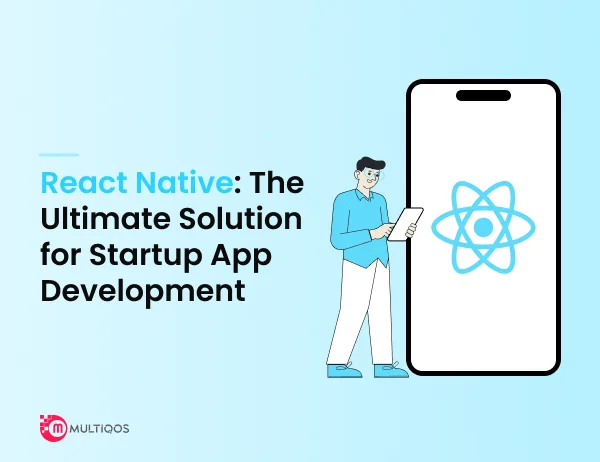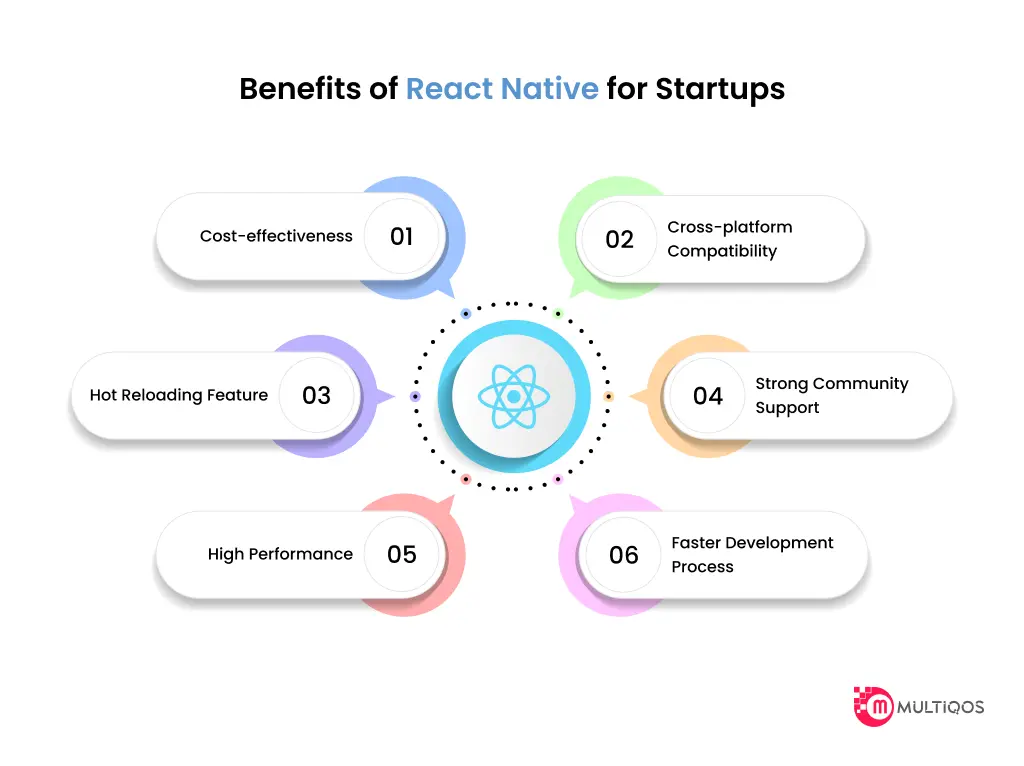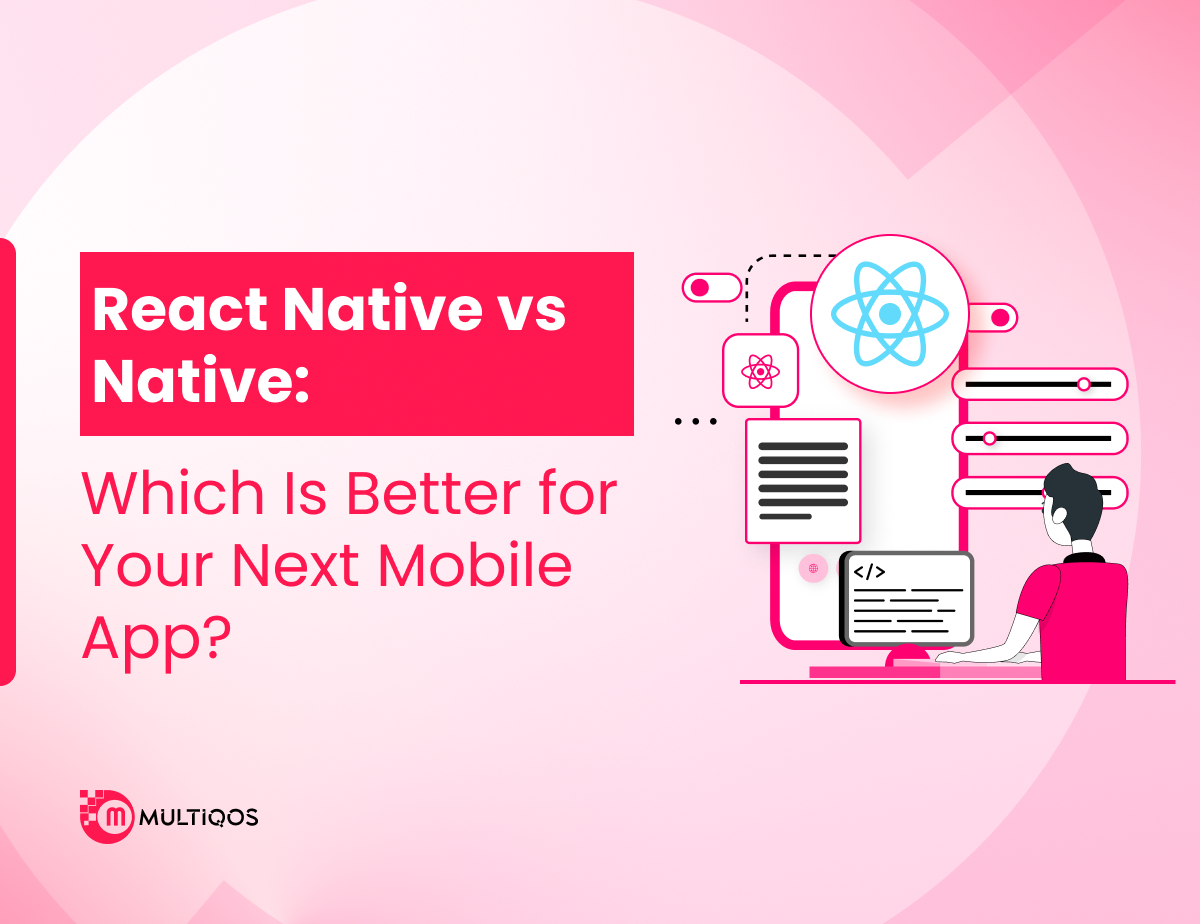Why React Native is a Game Changer for Startup App Development?

As technology has advanced, it is almost impossible to imagine life without mobile applications, which are crucial to businesses – particularly startups – to expand their reach, increase customer loyalty, and take advantage of myriad opportunities for growth.
Selecting the best framework for application development has wide implications towards the kind of venture it can create since it establishes the speed of development, the cost and quality of the final product.
Since its creation, React Native has changed the way mobile developers work by allowing them to build native-like apps for both iOS and Android using the same code.
According to a report by Persistence Market Research, the cross-platform app development market is expected to grow from $120 billion in 2023 to $546.7 billion by 2033, at a Compound Annual Growth Rate (CAGR) of 16.7%. This growth underscores the increasing adoption of frameworks like React Native among startups.
What is React Native?
React Native is an open-source JS framework for building native mobile apps which is developed by Facebook, this enables the developers to start the building processes using javascript or react. It quickly grew in popularity because of its features, where it allowed developers to achieve a native appearance but at the same time write code for only one platform.
It uses the React library to create user interfaces, and extends web development into mobile application development using native components.
Key Features
- Cross-platform development: Designed to be written once, run anywhere.
- Hot Reloading: Add or modify a line of code and see the effects right away.
- Modular architecture: Can easily be upgraded and maintained.
- Reusable components: Reduces the development and testing cost.
- Strong community support: Large availability of resources and plugins available.
Benefits of React Native for Startups
Cost-effectiveness
Creating apps that are under two different platforms such as the iOS and the Android operating system platforms may prove costly and also time consuming. The reusability of two code bases of platform for both Android and IOS saves the cost of recruiting two individual teams for development for different platforms.
Faster Development Process
React Native means that developers will be able to create applications faster, with the use of components that have been built earlier and code that can be used across different platforms. The flaws in the app have been fixed through the framework’s Hot Reloading that facilitates quick code changes without having to refresh the entire application.
Cross-platform Compatibility
React Native does guarantee that the applications created are effective in the iOS and Android devices simultaneously maintaining the usability standards between the two. This compatibility is especially important for startups who need to target a larger audience than only their clients but do not want to spend extra resources on constantly updating two or more versions of a certain code.
Hot Reloading Feature
Hot Reloading improves the efficiency of developing since it provides an opportunity to receive the visible result of code modifications as soon as possible. This feature proves useful when it comes to the management of bugs since it will reduce the amount of time that would have been used in the development process.
Strong Community Support
The social aspects of developing with React Native are remarkable, because you have a massive community, plus a myriad of resources, libraries, and third-party plugins. This help can be beneficial for startups wanting to seek solutions, assess the effectiveness of their apps, and learn updates in the field and its guidelines.
High Performance
As is already clear, React Native GUI applications are highly efficient in their flow and animation. It adopts the native components and fine-tunes the app performances to guarantee optimal rendering of the apps across the devices.
Technical Specifications of React Native
Core Architecture
The architecture of React Native centers around the React library and JavaScript which offers a solid basis for constructing modular and maintainable mobile solutions. Thanks to the designed architecture, there is no difficulty in implementing native modules, thereby improving the utility and performance of the produced applications.
Programming Languages Used
The primary language used in React Native is JavaScript, which is easily one of the most popular and approachable programming languages currently in existence. Also, developers can utilize native languages like Swift/Python, Objective-C, and Java while using native modules where necessary.
Key Libraries and Tools
- React Navigation: For implementing navigation in React Native apps.
- Redux: For state management.
- Axios: For handling HTTP requests.
- Jest: For testing.
- Expo: An open-source platform for developing and building React Native apps quickly.
Integration with Other Technologies
The seamless compatibility with different back-end platforms, databases and APIs enable the use of React Native to be easily implemented by startup companies based on their specific technical platform needs. It also supports integration with native code and gives developers the possibility to add elements specific to a particular plateforme when it is necessary.
React Native vs. Other Frameworks
React Native Vs. Flutter
This is another framework for implementing cross-platform applications where the code is written once and used across multiple platforms, developed by Google.
When it comes to similarities, both Flutter and React Native advantage of having a single code base as well as the hot-reloading feature where the application can be updated without relaunching the app, but the language used in Flutter is Dart not JavaScript.
React Native provides more tools and has a bigger community than Swift, and at the same time, Flutter uses gestures for UI and provides native-like speed.
Also Read: Flutter vs React Native in 2024.
React Native Vs. Xamarin
Xamarin is a cross-development platform that is owned by Microsoft to create applications using C# for multiple platforms. In comparison to using React Native in which development is made with JavaScript and React based, Xamarin offers a more native experience as it directly accesses native APIs. But, React Native commonly used for its own flexibility, shorter time for development, and vast community.
React Native Vs. Native App Development
Development of apps that are native to the operating system entails creating two applications that are distinctly different and designed uniquely for iOS utilizing Swift/Objective C and Android utilizing Java/Kotlin. Native apps can provide the best quality as well as the ability to access all the unique features of iOS, so React Native is considered to be a good middle ground that can offer reasonable performance, fast development, and relatively affordable to develop apps for both operating systems.
Application of React Native in Different Industries
E-commerce
Some of the benefits of using React Native include constructing apps for both platforms using a single code base to encourage efficient and powerful e-commerce apps. Some of the large companies like Shopify have adopted React Native to improve the firm’s position in the mobile markets.
Social Media
Social media platforms are useful for any new companies due to React Native technology, and the application’s animations, making them interactive for use by the audience. Instagram, Pinterest are some of the well-known applications that have developed their mobile applications using React Native.
Finance and Banking
In finance and banking industries, React Native is adopted to develop secure, mobile apps that are easy to use and resistant to cyber threats. This framework has many beneficial qualities: flexibility and fast work, due to the possibility of the framework’s division into modules; a supportive community of developers, increasing the dependability of the financial applications.
Healthcare
Healthcare has adopted React Native to create apps for people to book appointments, manage their health issues, and receive consultations online. The above developments make the framework to be friendly with different devices, and this increases the coverage of healthcare apps.
Travel and Tourism
Travel & tourism helps when using features like real time update, smooth navigation, and maps in the need of applications built using React Native. Startups utilize this framework to develop intuitive apps for their consumers to improve their overall experience in traveling.
Successful Startups Using React Native
Many other popular startups have adopted this technology to create their new iOS and Android app. For instance, as adopted by Airbnb, one of the initial reasons to join React Native was to enhance the speed at which they developed their applications.
The above slots company success story despite the later adoption of React native development services underscores the framework’s potential.
Impact on Business Growth
Organizations that have adopted the technology for building products notice factors such as faster time-to-market, low development costs and better performance of apps. The following explanations explain why these factors contribute to business growth because startups avoid facing technical issues.
Challenges and Limitations of React Native
Performance Issues on Older Devices
In the context of using the application, it is also worth noting that due to complex animations, React Native apps can consume excess resources, and, therefore, lag on older devices or those with lower-performance processors. That is why optimizing the app, as well as using native modules can help minimize the mentioned issues.
Limited Access to Native APIs
While working with React Native, developers can have access to various native APIs and though using native code is limited sometimes, this may be required to implement specific functionalities in an application. This requirement can naturally lead to a greater amount of difficulty and time required to implement some features.
Larger App Size
One of the apparent disadvantages of the React Native is the fact that the applications it produces are larger than the ones built with native solutions. This is because the software bundles the JavaScript runtime inter and other dependencies as well. It is now common knowledge that the apps should be optimized and the tools such as ProGuard and Hermes, among others, should be used to cut the application size.
Learning Curve for New Developers
As for the developers, it is crucial to note that for those who begin their work in the framework of React Native, there could be certain difficulties due to inexperience with JavaScript or React. However, one would find all the documentation as well as an awesome community to work with to make the process easier.
Latest Innovations in React Native
Recent Updates
Like other frameworks, React Native constantly develops with frequent updates and novelties. The most recent updates have added necessary fixes in increasing performance as well as in adding better developer tools and broadening support for new devices and Operating systems.
New Features
New features in React Native include changes such as; more flexibility in how users can customize the configurations; better tools for debugging; and better ways to optimize the performance of the applications. That is why these features enable flash developers to build more efficient and stable applications.
Upcoming Developments
React native team is always updating the development processes and bringing new features on board. Future updates include an improved capability with simultaneous rendering, improved observability, and more adaptation into other tools and frameworks.
Future Prospects of React Native
Predictions for the Next 5 Years
It is likely that in the future, React Native will become one of the leading frameworks for creating applications thanks to flexibility, relatively low cost, and active user community. Perhaps, the further development of the framework will bring more sophisticated characteristics, global approaches, and optimizations that will contribute to the use of the framework not only by startup companies but also by other businesses.
Potential Market Growth
There is expected to be a continued trend in the usage of cross-platform mobile app development, thus the likelihood of increased framework use such as React Native. This growth will be driven by the expanding demand for optimum functionality and peak performance mobile applications across multiple sectors.
Evolution of the Framework
It outlines how the future of React Native will be relevant, including optimization, integration with new technologies, and a better experience for developers. Based on the increasing number of startups and businesses adopting React Native, this framework is also progressing with further developments to fit into them.
Step-by-Step Guide to Getting Started with React Native
Setting Up the Development Environment
To use the React Native for the first time, one has to configure the development environment. This involves installing Node. js, React Native CLI, and an IDE such as Visual Studio Code for most of the listed components.
Creating a New React Native Project
Setting up your environment involves installing Node.js and Watchman, along with the newest version of the JavaScript Runtime (JSC). Once this has been done, you can create a new React Native project using the cloned React Native CLI. This includes some running of commands to start working on your project and creating other project ingredients.
Basic Components and Navigation
Among basic components, which React Native offers, there are Text, View, Button, etc., allowing you to create an app’s UI. Some other components also assist in navigating and routing, for instance, libraries such as React Navigation.
Debugging and Testing
Debugging and testing is very important in the development process of an app and React Native provides several approaches to this. There are several ways to ensure that your app works just fine, including using the debugger that is built-in, remote debugging tools, as well as testing libraries, for example, Jest.
Expert Insights
Interviews with Industry Professionals
The strengths of the React Native are presented by industry specialists for startups which include development speed, affordability, and audience reach. These insights bring focus to pragmatics and benefits when opting for React Native for your creation of the mobile app.
Quotes from React Native Developers
A lot of React Native developers said that the framework has flexibility, simplicity, and a strong community in its favor. They show that this framework has its advantages as well as suitability for creating start-up apps.
Conclusion
The benefits of React Native for startups include affordability, quick development time, ability to work on both platforms iOS and Android, and wide support from the community. Because of its technical characteristics, versatility in industries, and a long-term perspective, it is perfect for mobile app development.
Therefore, for startups that are in the process of designing and developing new mobile applications, React Native is really helpful and effective. Since it can create high-performance apps from a single code, coupled with the fact that there is constant development going on and a vibrant community supporting it, React Native will remain an invaluable commodity for start-ups in the foreseeable future.
FAQ on React Native for Startup App Development
React Native is a framework to develop mobile applications with the native environment from JavaScript and React.
With cost-efficient development, quick delivery time, platform independency, and communities, React Native is suitable for startups.
Compared to other tools, such as Flutter and Xamarin, React native stands out with its mature ecosystem, relatively simplicity, and a great community. Though each framework is original in its nature, they are equally effective and optimal for specific circumstances.
Some of the advantages of implementing react native include, it is inexpensive, quick to build, portable, use hot swapping, a large community and effective.
It would be beneficial to use React Native in industries like e-commerce, social media, finance and banking, health, and tourism.
To begin creating a React Native application, you should install the software tools necessary for the development, create a new application, understand the basic elements of the application, and navigate within the application, debug the issues that may occur, and test your application to ensure it works effectively.
React Native offers great potential for further development and enhancement with frequent updates, improved functionality, and increasing popularity within different fields. Likewise, the framework should incorporate better features and further optimize as progression advances in the future.
Get In Touch








